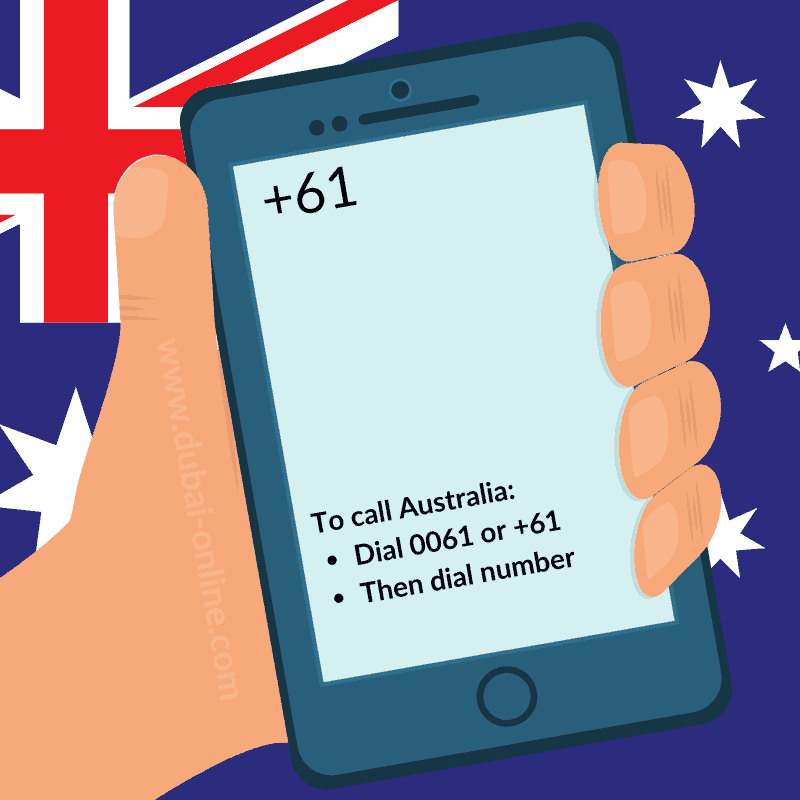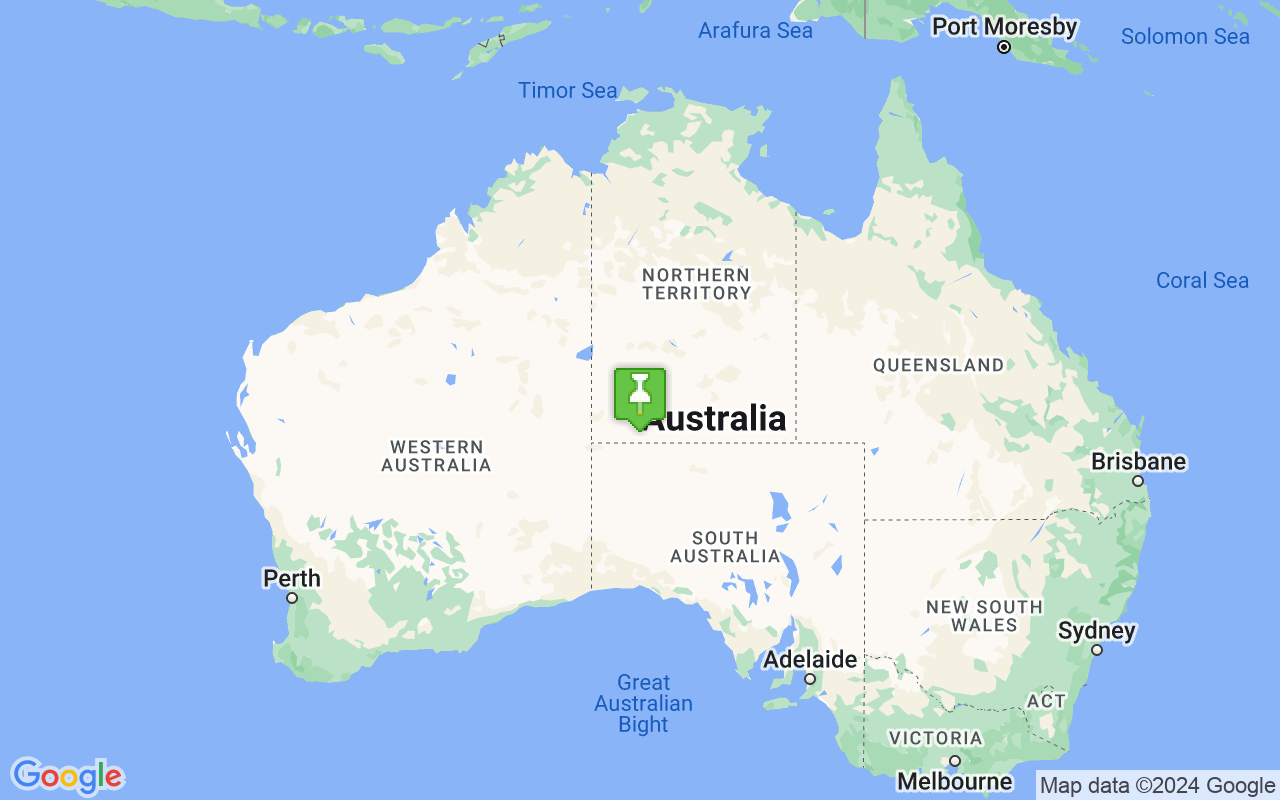61 is the country code for Australia.
Canberra is the capital city of Australia.
How to Call Australia from Dubai (United Arab Emirates)
To call a telephone number in Australia from Dubai (United Arab Emirates):
- Dial the international call prefix. For calls from Dubai (United Arab Emirates), this is 00 (or '+' from mobile phones).
- Dial the country code for Australia - 61.
- Dial the subscriber number, omitting the first zero if there is one.
Landlines – City/Area Telephone Codes in Australia
Landline numbers in Australia are 10 digits long (including the leading 0 – trunk prefix).
The first digits of the number indicate the geographic area of the subscriber.
For example, in the Australian number 029XXXXXXX, 029 is the area code and indicates that the subscriber is located in Sydney.
To call a number in Australia from another country, dial the international call prefix (00/+), the phone code for Australia (61), and then the subscriber number without the leading 0 e.g. 00-61-29XXXXXXX or +61-29XXXXXXX.
Mobile Telephone Numbers in Australia
Mobile phone numbers in Australia are 10 digits long and begin with 04 (05 is reserved for future use) e.g. 04XXXXXXXX.
To call a mobile phone number in Australia from overseas, dial the international exit call prefix (00/+), the Australia country code (61), and then the subscriber number without the leading 0 e.g. 00-61-4XXXXXXXX or +61-4XXXXXXXX.

Fixed-Line Usage in Australia
Data from the World Bank shows that in 2022 there were 24.48 landline telephone subscribers for every 100 people living in Australia.
In 2003 there were 53.10 fixed-line telephone subscriptions for every 100 people living in Australia.
The table below shows how fixed-line phone subscription statistics have changed in recent years.
| Year | Landline Telephone Subscriptions (per 100 People) in Australia |
|---|---|
| 2022 | 24.48 |
| 2021 | 25.91 |
| 2020 | 21.25 |
| 2019 | 24.45 |
| 2018 | 32.83 |
| 2017 | 34.40 |
| 2016 | 35.05 |
| 2015 | 35.68 |
| 2014 | 39.16 |
| 2013 | 44.78 |
| 2012 | 46.07 |
| 2011 | 47.29 |
| 2010 | 48.25 |
| 2009 | 49.44 |
| 2008 | 44.10 |
| 2007 | 46.85 |
| 2006 | 48.57 |
| 2005 | 50.17 |
| 2004 | 52.05 |
| 2003 | 53.10 |
Mobile Phone Usage in Australia
According to the World Bank, there were 107.03 mobile phone subscribers per 100 people in 2022.
This is a big increase from 2003 when there were 72.83 mobile phone subscribers for every 100 people.
Mobile telephone subscription statistics by year for Australia are shown in the table below.
| Year | Mobile Phone Subscriptions (per 100 People) in Australia |
|---|---|
| 2022 | 107.03 |
| 2021 | 104.52 |
| 2020 | 105.23 |
| 2019 | 110.30 |
| 2018 | 110.65 |
| 2017 | 108.42 |
| 2016 | 109.73 |
| 2015 | 108.19 |
| 2014 | 106.78 |
| 2013 | 107.91 |
| 2012 | 107.08 |
| 2011 | 106.40 |
| 2010 | 102.18 |
| 2009 | 102.49 |
| 2008 | 104.10 |
| 2007 | 102.06 |
| 2006 | 96.55 |
| 2005 | 91.32 |
| 2004 | 82.71 |
| 2003 | 72.83 |
Exchange Rate
The currency of Australia is the Australian dollar (AUD).
Exchange rates between the Australian dollar and the UAE dirham (AUD to AED, AED to AUD) are:
- 1 Australian dollar (AUD) = 2.36 AED
- 1 UAE dirham (AED) = 0.42 AUD
Exchange rates on this page were last updated on .
Useful Information
Australia is a country situated between the Indian Ocean and the Pacific Ocean. It comprises mainland Australia, the island of Tasmania, and thousands of smaller islands.
Its name comes from the Latin words ‘Terra Australis’, meaning ‘southern land’. It is sometimes referred to as ‘down under.’
The first Australians were most likely people who migrated to Australia by crossing land bridges and short sea passages from Southeast Asia around 65,000 years ago.
In 1768, the British Government commissioned James Cook to lead an expedition to the South Pacific to observe the transit of Venus across the sun. The expedition was also tasked with discovering new lands in the South Pacific and claiming them for Britain. In 1770, Cook and his crew reached New South Wales. They then sailed north, charting Australia’s eastern coastline and claimed the land for Britain.
The British began to establish penal colonies in Australia in 1788. Before this, the British had primarily used North America as a place to send convicts. However, with the outbreak of the American Revolution, this option was no longer available. Britain then turned to its remaining colonies, including Australia, as a place to send its convicts. The first penal colony in Australia was established at Port Jackson, which is now Sydney.
The descendants of convicts make up a significant part of the current Australian population.
Data from the World Bank shows that in 2022 the population of Australia was 26,005,540.
In 2003, the population was 19,720,737. Over the last 20 years, the population grew by 6,284,803 (31.9%).
The table below shows how the total population has changed in recent years.
| Year | Total Population of Australia |
|---|---|
| 2022 | 26,005,540 |
| 2021 | 25,685,412 |
| 2020 | 25,649,248 |
| 2019 | 25,334,826 |
| 2018 | 24,963,258 |
| 2017 | 24,592,588 |
| 2016 | 24,190,907 |
| 2015 | 23,815,995 |
| 2014 | 23,475,686 |
| 2013 | 23,128,129 |
| 2012 | 22,733,465 |
| 2011 | 22,340,024 |
| 2010 | 22,031,750 |
| 2009 | 21,691,653 |
| 2008 | 21,249,199 |
| 2007 | 20,827,622 |
| 2006 | 20,450,966 |
| 2005 | 20,176,844 |
| 2004 | 19,932,722 |
| 2003 | 19,720,737 |
Useful information about Australia:
- Two-letter Country Code (ISO 3166-1 alpha-2): AU
- Three-letter Country Code (ISO 3166-1 alpha-3): AUS
- Region: Oceania
- Sub-region: Australia and New Zealand
- Capital: Canberra
- Area: 7,692,024 square km
- Language(s): English
Australia Map
A map of Australia is shown below.


